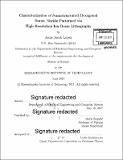Characterization of nanostructured hexagonal boron nitride patterned via high-resolution ion beam lithography
Author(s)
López, Josué Jacob
DownloadFull printable version (4.654Mb)
Other Contributors
Massachusetts Institute of Technology. Department of Electrical Engineering and Computer Science.
Advisor
Marin Soljačić.
Terms of use
Metadata
Show full item recordAbstract
The forefront of polariton research in two-dimensional (2D) materials focuses on pushing the limits of patterning 2D materials into nanoresonators and other nanophotonic structures that manipulate highly confined polaritons for technologically relevant near-IR and mid-IR applications. Furthermore, tuning the properties of hexagonal boron nitride, graphene, and other 2D materials in-plane and stacking them into heterostructures has the potential to create hybrid optical, electronic, thermal, and mechanical properties with a wealth of new functions. To fully tailor these novel properties, controlled nanoscale patterning of these and other van der Waals materials is essential. Moreover, it becomes imperative to understand how patterning and geometries modify the properties within each layer or introduce defects that affect the interfaces of layered 2D heterostructures. Herein, we demonstrate high-resolution patterning of h-BN via both helium and neon ion beams and pattern a h-BN grating with a 35 nm pitch and 20 nm feature size. We study varying degrees of nanostructuring and defects via Raman spectroscopy, photo-thermal microscopy, and scattering-type scanning near-field optical microscopy and observe complimentary information about the phonon modes and the absorption and scattering of light from such nanostructures. Specifically, we observe geometry and layer dependent photo-thermal expansion of h-BN nanostructures that are mediated by phonons. This work demonstrates a thorough understanding of directly patterned 2D materials with ion beams and demonstrates that far-field and near-field measurements are essential in understanding how the nanostructuring of 2D materials can tune their properties.
Description
Thesis: S.M., Massachusetts Institute of Technology, Department of Electrical Engineering and Computer Science, 2017. Cataloged from PDF version of thesis. Includes bibliographical references (pages 51-57).
Date issued
2017Department
Massachusetts Institute of Technology. Department of Electrical Engineering and Computer SciencePublisher
Massachusetts Institute of Technology
Keywords
Electrical Engineering and Computer Science.